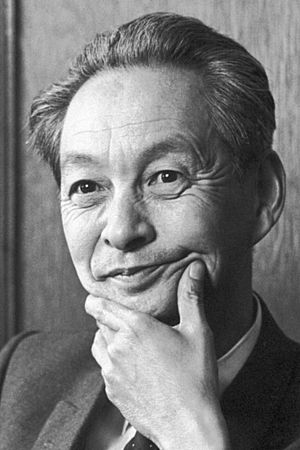Shin'ichirō Tomonaga facts for kids
Quick facts for kids
Shin'ichirō Tomonaga
|
|
|---|---|

Tomonaga in 1965
|
|
| Born | March 31, 1906 |
| Died | July 8, 1979 (aged 73) Tokyo, Japan
|
| Alma mater | Kyoto Imperial University |
| Known for | Quantum electrodynamics Schwinger–Tomonaga equation Tomonaga–Luttinger liquid |
| Awards | Asahi Prize (1946) Lomonosov Gold Medal (1964) Nobel Prize in Physics (1965) |
| Scientific career | |
| Fields | Theoretical physics |
| Institutions | Leipzig University Institute for Advanced Study Tokyo University of Education RIKEN University of Tokyo |
Shinichiro Tomonaga (朝永 振一郎, Tomonaga Shin'ichirō, March 31, 1906 – July 8, 1979), often called Sin-Itiro Tomonaga in English, was a Japanese physicist. He was very important in creating a special theory called quantum electrodynamics. For this work, he won the Nobel Prize in Physics in 1965. He shared the award with two other scientists, Richard Feynman and Julian Schwinger.
Contents
Life and Discoveries
Early Life and Education
Shin'ichirō Tomonaga was born in Tokyo, Japan, in 1906. He was the oldest son of a philosopher named Tomonaga Sanjūrō.
He went to Kyoto Imperial University in 1926. Another famous scientist, Hideki Yukawa, who also won a Nobel Prize, was one of his classmates. After finishing his first degree, Tomonaga stayed at the university for three more years as an assistant.
In 1931, he joined a research group at RIKEN, led by Yoshio Nishina.
Working with Famous Scientists
In 1937, Tomonaga went to work at Leipzig University in Germany. There, he worked with the research team of Werner Heisenberg, another very famous physicist.
Two years later, in 1939, he returned to Japan because World War II was starting. Even though he was back in Japan, he finished his PhD degree from the University of Tokyo. His special project was about nuclear materials, based on the work he did in Leipzig.
Important Discoveries During the War
In Japan, Tomonaga became a professor at the Tokyo University of Education, which is now Tsukuba University. During the war, he studied things like the magnetron, which is used in microwave ovens, and a theory about tiny particles called mesons. He also developed his own "super-many-time theory."
In 1948, Tomonaga and his students looked again at an older paper from 1939. This paper tried to solve a big problem in QED. QED is a theory that describes how light and matter interact. The problem was that calculations in QED often led to "infinite" answers, which don't make sense in the real world.
Tomonaga used his new theory to make the calculations faster and clearer. He and his students found that the older paper had missed an important part. When they added this missing part, their calculations gave normal, "finite" answers! This was a huge breakthrough. Tomonaga had found a way to fix the problem of infinite answers. This method is called renormalization. He discovered this method at the same time as Julian Schwinger.
Post-War Work and Nobel Prize
In 1949, a famous scientist named J. Robert Oppenheimer invited Tomonaga to work at the Institute for Advanced Study in Princeton, USA. There, Tomonaga studied how many tiny particles act together in a system.
The next year, he went back to Japan. He suggested a new idea called the Tomonaga–Luttinger liquid, which describes how electrons behave in certain materials.
In 1955, he helped start the Institute for Nuclear Study at the University of Tokyo.
In 1965, Tomonaga won the Nobel Prize in Physics. He shared it with Julian Schwinger and Richard Feynman. They won for their work on QED, especially for discovering the renormalization method. This method was key to making QED a useful theory.
Tomonaga passed away in Tokyo in 1979 from throat cancer.
Personal Life and Honors
Tomonaga married Ryōko Sekiguchi in 1940. They had two sons and one daughter.
He received many honors during his life. He was given the Order of Culture in 1952 and the Grand Cordon of the Order of the Rising Sun in 1976.
In 2015, statues of three Nobel Prize winners, Shin'ichirō Tomonaga, Leo Esaki, and Makoto Kobayashi, were placed in Central Park in Tsukuba City, Japan, to honor their great contributions to science.
Awards and Recognition
- 1946 – Asahi Prize
- 1948 – Japan Academy Prize
- 1951 – Member of the Japan Academy
- 1952 – Order of Culture
- 1964 – Lomonosov Gold Medal
- 1965 – Nobel Prize in Physics
- 1965 – Elected to the United States National Academy of Sciences
- 1966 – Elected to the American Philosophical Society
- 1967 – Grand Cordon of the Order of the Rising Sun
- 1975 – Elected to the American Academy of Arts and Sciences
See also
 In Spanish: Shin'ichirō Tomonaga para niños
In Spanish: Shin'ichirō Tomonaga para niños
- List of Japanese Nobel laureates
- List of Nobel laureates affiliated with Kyoto University
- List of Nobel laureates affiliated with the University of Tokyo

